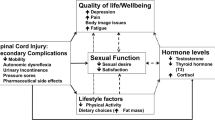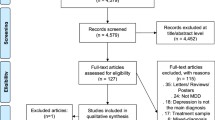Abstract
Multiple sclerosis (MS) is the most common cause of progressive neurological disability in young adults. In addition to spasticity, tremors, weakness, sensory disturbances, depression, cognitive problems, and bladder or bowel dysfunction, sexual dysfunction (SD) is also a prevalent and destructive manifestation of the disease that severely affects quality of life. Evaluation of this disorder requires insight into the primary (changes that directly affect libido, sexual response and orgasm due to direct damage to the nervous system), secondary (complaints which are related to the physical disability of MS, such as fatigue, muscle rigidity, weakness and spasms), and tertiary (emotional, social and cultural aspects of MS) components of MS-associated SD. Given the complexity and multifactorial nature of SD, a multidisciplinary approach is necessary when treating patients with MS. The aim of this Review is to provide a holistic approach to the evaluation and management of SD in patients with MS, incorporating the latest data from the fields of urology, neurology, nursing, social work, and psychology. What is currently known regarding the evaluation and management of SD in patients with MS will be presented from the perspective of these specialties.
Key Points
-
Sexual dysfunction is common in patients with multiple sclerosis (MS)
-
A variety of factors, including MS-related disease activity, MS symptoms, depression, and effects of pharmacological therapy, can contribute to sexual dysfunction in patients with MS
-
All MS patients should be specifically queried about sexual function
-
Physicians, nurses, extenders, social workers, case mangers and psychologists represent the core team that can help orchestrate a truly multidisciplinary approach and management scheme for the complex problem of sexual dysfunction in patients with MS
This is a preview of subscription content, access via your institution
Access options
Subscribe to this journal
Receive 12 print issues and online access
$209.00 per year
only $17.42 per issue
Buy this article
- Purchase on Springer Link
- Instant access to full article PDF
Prices may be subject to local taxes which are calculated during checkout
Similar content being viewed by others
References
Anderson DW et al. (1992) Revised estimate of the prevalence of multiple sclerosis in the United States. Ann Neurol 31: 333–336
Zorzon M et al. (2001) Sexual dysfunction in multiple sclerosis: a 2-year follow-up study. J Neurol Sci 187: 1–5
Demirkiran M et al. (2006) Multiple sclerosis patients with and without sexual dysfunction: are there any differences? Mult Scler 12: 209–214
McCabe MP (2004) Exacerbation of symptoms among people with multiple sclerosis: impact on sexuality and relationships over time. Arch Sex Behav 33: 593–601
Zorzon M et al. (1999) Sexual dysfunction in multiple sclerosis: a case–control study. I. Frequency and comparison of groups. Mult Scler 5: 418–427
Nortvedt MW et al. (2001) Reduced quality of life among multiple sclerosis patients with sexual disturbance and bladder dysfunction. Mult Scler 7: 231–235
Miller A and Dishon S (2006) Health-related quality of life in multiple sclerosis: the impact of disability, gender and employment status. Qual Life Res 15: 259–271
Rubin R (2005) Communication about sexual problems in male patients with multiple sclerosis. Nurs Stand 19: 33–37
Mattson D et al. (1995) Multiple sclerosis. Sexual dysfunction and its response to medications. Arch Neurol 52: 862–868
Barak Y et al. (1996) Sexual dysfunction in relapsing-remitting multiple sclerosis: magnetic resonance imaging, clinical, and psychological correlates. J Psychiatry Neurosci 21: 255–258
Hulter BM and Lundberg PO (1995) Sexual function in women with advanced multiple sclerosis. J Neurol Neurosurg Psychiatry 59: 83–86
Zivadinov R et al. (2003) Sexual dysfunction in multiple sclerosis: a MRI, neurophysiological and urodynamic study. J Neurol Sci 210: 73–76
Janardhan V and Bakshi R (2000) Quality of life and its relationship to brain lesions and atrophy on magnetic resonance images in 60 patients with multiple sclerosis. Arch Neurol 57: 1485–1491
Nortvedt MW et al. (2007) Prevalence of bladder, bowel and sexual problems among multiple sclerosis patients two to five years after diagnosis. Mult Scler 13: 106–112
Yang CC et al. (2000) Cortical evoked potentials of the dorsal nerve of the clitoris and female sexual dysfunction in multiple sclerosis. J Urol 164: 2010–2013
McDougall AJ and McLeod JG (2003) Autonomic nervous system function in multiple sclerosis. J Neurol Sci 215: 79–85
Ghezzi A et al. (1995) Erectile impotence in multiple sclerosis: a neurophysiological study. J Neurol 242: 123–126
Staerman F et al. (1996) Value of nocturnal penile tumescence and rigidity (NPTR) recording in impotent patients with multiple sclerosis. Int J Impot Res 8: 241–245
Gruenwald I et al. (2007) Sexual dysfunction in females with multiple sclerosis: quantitative sensory testing. Mult Scler 13: 95–105
Seçil Y et al. (2007) Sexual dysfunction and sympathetic skin response recorded from the genital region in women with multiple sclerosis. Mult Scler 13: 742–748
Borello-France D et al. (2004) Bladder and sexual function among women with multiple sclerosis. Mult Scler 10: 455–461
Hennessey A et al. (1999) Urinary, faecal and sexual dysfunction in patients with multiple sclerosis. J Neurol 246: 1027–1032
Lottman PE et al. (1998) Sexual dysfunction in men with multiple sclerosis—a comprehensive pilot-study into etiology. Int J Impot Res 10: 233–237
Grønning M et al. (1990) Multivariate analyses of factors associated with unemployment in people with multiple sclerosis. J Neurol Neurosurg Psychiatry 53: 388–390
Rao SM et al. (1991) Cognitive dysfunction in multiple sclerosis. I. Frequency, patterns, and prediction. Neurology 41: 685–691
Sanfilipo MP et al. (2006) Gray and white matter brain atrophy and neuropsychological impairment in multiple sclerosis. Neurology 66: 685–692
Lanz M et al. (2007) Brain atrophy and cognitive impairment in multiple sclerosis: a review. J Neurol 254 (Suppl 2): II43–II48
Krupp LB et al. (2004) Donepezil improved memory in multiple sclerosis in a randomized clinical trial. Neurology 63: 1579–1585
Amato MP (2005) Donepezil for memory impairment in multiple sclerosis. Lancet Neurol 4: 72–73
Hadjimichael O et al. (2008) Fatigue characteristics in multiple sclerosis: the North American Research Committee on Multiple Sclerosis (NARCOMS) survey. Health Qual Life Outcomes 6: 100
Tomassini V et al. (2004) Comparison of the effects of acetyl-L-carnitine and amantadine for the treatment of fatigue in multiple sclerosis: results of a pilot, randomised, double-blind, crossover trial. J Neurol Sci 218: 103–108
Lebrun C et al. (2006) Levocarnitine administration in multiple sclerosis patients with immunosuppressive therapy-induced fatigue. Mult Scler 12: 321–324
Rae-Grant AD et al. (1999) Sensory symptoms of multiple sclerosis: a hidden reservoir of morbidity. Mult Scler 5: 179–183
Morrell MJ et al. (2003) Higher androgens and weight gain with valproate compared with lamotrigine for epilepsy. Epilepsy Res 54: 189–199
Hamed SA (2008) Neuroendocrine hormonal conditions in epilepsy: relationship to reproductive and sexual functions. Neurologist 14: 157–169
Szupera Z (2007) The role of the antiepileptic drugs at the development of the sexual dysfunctions in male epileptic patients [Hungarian]. Ideggyogy Sz 60: 4–13
Minden SL et al. (1987) Depression in multiple sclerosis. Gen Hosp Psychiatry 9: 426–434
Sadovnick AD et al. (1996) Depression and multiple sclerosis. Neurology 46: 628–632
Joffe RT et al. (1987) Mood disorder and multiple sclerosis. Arch Neurol 44: 376–378
Patten SB et al. (2000) Biopsychosocial correlates of lifetime major depression in a multiple sclerosis population. Mult Scler 6: 115–120
Wilken JA and Sullivan C (2007) Recognizing and treating common psychiatric disorders in multiple sclerosis. Neurologist 13: 343–354
Clayton AH et al. (2001) Substitution of an SSRI with bupropion sustained release following SSRI-induced sexual dysfunction. J Clin Psychiatry 62: 185–190
Sanders AS et al. (2000) The Multiple Sclerosis Intimacy and Sexuality Questionnaire-19 (MSISQ-19). Sex Disabil 18: 3–26
Rosen R et al. (2000) The Female Sexual Function Index (FSFI): a multidimensional self-report instrument for the assessment of female sexual function. J Sex Marital Ther 26: 191–208
Derogatis LR et al. (2002) The Female Sexual Distress Scale (FSDS): initial validation of a standardized scale for assessment of sexually related personal distress in women. J Sex Marital Ther 28: 317–330
Fowler CJ et al. (2005) A double blind, randomised study of sildenafil citrate for erectile dysfunction in men with multiple sclerosis. J Neurol Neurosurg Psychiatry 76: 700–705
Bodner DR et al. (1999) Intraurethral alprostadil for treatment of erectile dysfunction in patients with spinal cord injury. Urology 53: 199–202
Kapoor VK et al. (1993) Intracavernous papaverine for impotence in spinal cord injured patients. Paraplegia 31: 675–677
Denil J et al. (1996) Vacuum erection device in spinal cord injured men: patient and partner satisfaction. Arch Phys Med Rehabil 77: 750–753
Kayigil O et al. (2007) Effects of transanal pelvic plexus stimulation on penile erection: clinical implications. Int Urol Nephrol 39: 1195–1201
Shafik A et al. (2008) Percutaneous perineal electrostimulation induces erection: clinical significance in patients with spinal cord injury and erectile dysfunction. J Spinal Cord Med 31: 40–43
Long CY et al. (2006) A randomized comparative study of the effects of oral and topical estrogen therapy on the vaginal vascularization and sexual function in hysterectomized postmenopausal women. Menopause 13: 737–743
Shifren JL et al. (2000) Transdermal testosterone treatment in women with impaired sexual function after oophorectomy. N Engl J Med 343: 682–688
Gragasin FS et al. (2004) The neurovascular mechanism of clitoral erection: nitric oxide and cGMP-stimulated activation of BKCa channels. FASEB J 18: 1382–1391
Shields KM and Hrometz SL (2006) Use of sildenafil for female sexual dysfunction. Ann Pharmacother 40: 931–934
Dasgupta R et al. (2004) Efficacy of sildenafil in the treatment of female sexual dysfunction due to multiple sclerosis. J Urol 171: 1189–1193
Sipski ML et al. (1995) Physiological parameters associated with psychogenic sexual arousal in women with complete spinal cord injuries. Arch Phys Med Rehabil 76: 811–818
Lenz ER et al. (1997) The middle-range theory of unpleasant symptoms: an update. ANS Adv Nurs Sci 19: 14–27
Foley F (online 1 January 2008) Talking with Your MS Patients about Difficult Topics: Talking about Sexual Dysfunction [http://www.nationalmssociety.org /for-professionals/healthcare-professionals /publications/download.aspx?id=175] (accessed 18 December 2008)
O'Connor EJ et al. (2008) The impact of neurological illness on marital relationships. J Sex Marital Ther 34: 115–132
Acknowledgements
This project was supported by the Once Upon A Time Foundation, the Cain/Denius Comprehensive Center for Mobility Research, the Irene Wadel and Robert Atha Fund, the Kenney Marie Dixon Pickens fund, and the Jean Ann and Steve Brock Fund for Medical Sciences (all to EM Frohman). SG Fletcher would like to acknowledge The Felecia Cain Fellowship Endowment for Female Pelvic Medicine, Reconstructive Surgery and Neurourology.
Author information
Authors and Affiliations
Corresponding author
Ethics declarations
Competing interests
The authors declare no competing financial interests.
Rights and permissions
About this article
Cite this article
Fletcher, S., Castro-Borrero, W., Remington, G. et al. Sexual dysfunction in patients with multiple sclerosis: a multidisciplinary approach to evaluation and management. Nat Rev Urol 6, 96–107 (2009). https://doi.org/10.1038/ncpuro1298
Received:
Accepted:
Issue Date:
DOI: https://doi.org/10.1038/ncpuro1298
This article is cited by
-
Quantification and Proximal-to-Distal Distribution Pattern of Tibial Nerve Lesions in Relapsing-Remitting Multiple Sclerosis
Clinical Neuroradiology (2023)
-
Comprehensive Approach to Management of Multiple Sclerosis: Addressing Invisible Symptoms—A Narrative Review
Neurology and Therapy (2021)
-
Sexual Dysfunction in Patients with Multiple Sclerosis from Argentina: What are the Differences Between Women and Men?
Sexuality and Disability (2019)
-
A Mindfulness Psychoeducational Group Intervention Targeting Sexual Adjustment for Women with Multiple Sclerosis and Spinal Cord Injury: A Pilot Study
Sexuality and Disability (2016)
-
An update on sexual function and dysfunction in women
Archives of Women's Mental Health (2015)



